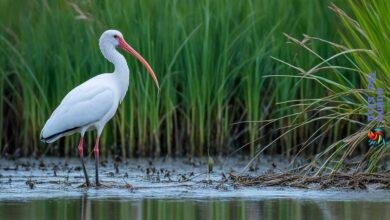Brazil, the largest country in South America, is known for its rich biodiversity and vibrant culture. Among its numerous natural symbols, the national bird, the Rufous-bellied Thrush (Turdus rufiventris), holds a special place.
This melodious songbird, also known as «sabiá-laranjeira» in Portuguese, is celebrated for its enchanting song and striking appearance. In this comprehensive blog, we will explore the Rufous-bellied Thrush’s characteristics, habitat, cultural significance, and the role it plays in Brazil’s natural heritage.

Description and Characteristics
Appendix: Interesting Facts about the Rufous-Bellied Thrush
- Scientific Name: Turdus rufiventris
- Family: Turdidae (thrushes)
- Lifespan: Typically 4-5 years in the wild
- Breeding Season: August to December, coinciding with the southern hemisphere’s spring and early summer
- Nest: The bird builds a cup-shaped nest using twigs, leaves, and mud, usually located in trees or shrubs.
- Clutch Size: Typically 2-3 eggs, which are incubated by the female for about 13-14 days.
- Feeding Habits: Omnivorous, feeding on fruits, insects, and small invertebrates.
- Conservation Status: Classified as «Least Concern» by the International Union for Conservation of Nature (IUCN), but local populations may be affected by habitat loss and other threats.
Physical Appearance
The Rufous-bellied Thrush is a medium-sized songbird, measuring approximately 25 centimeters (10 inches) in length. It is easily recognizable by its distinctive rufous (reddish-brown) underparts, which contrast with its olive-brown upperparts. The bird has a sturdy build with a slightly curved beak, ideal for foraging. Its eyes are dark, and its legs are a pale pinkish color.
Song and Behavior
One of the most notable features of the Rufous-bellied Thrush is its melodious song. The bird is renowned for its rich, flute-like notes that can be heard during the early morning and late afternoon. The song is a complex series of whistles and trills, often delivered from a high perch. This vocal prowess has earned the bird a special place in Brazilian folklore and literature.
In terms of behavior, the Rufous-bellied Thrush is an active forager, feeding on a variety of fruits, insects, and small invertebrates. It is often seen hopping on the ground, searching for food, or perching on branches. The bird is known for its adaptability, thriving in both urban and rural environments.
Habitat and Distribution
Geographic Range
The Rufous-bellied Thrush is widely distributed across Brazil, from the Amazon rainforest in the north to the subtropical regions in the south. Its range extends into neighboring countries, including Argentina, Paraguay, Bolivia, and Uruguay. This broad distribution is a testament to the bird’s adaptability to different climates and habitats.
Preferred Habitats
The Rufous-bellied Thrush inhabits a variety of environments, including forests, woodlands, gardens, and urban parks. It prefers areas with dense vegetation and plenty of food resources. In urban settings, the bird can often be seen in backyards, city parks, and even on streets lined with trees. This adaptability has allowed it to flourish in diverse landscapes, from the Amazon basin to the bustling cities of Brazil.
Cultural Significance
Symbolism and Folklore
The Rufous-bellied Thrush holds a significant place in Brazilian culture and folklore. It is often associated with themes of love, nostalgia, and the beauty of nature. The bird’s song is a symbol of the Brazilian landscape, evoking memories of serene mornings and tranquil evenings.
In Brazilian literature and music, the Rufous-bellied Thrush is a recurring motif. Celebrated poets like Olavo Bilac and João de Barro have referenced the bird in their works, highlighting its enchanting song and symbolic resonance. In traditional Brazilian music, particularly in the genre of choro, the bird’s melodious notes are often mimicked by instruments, adding a layer of natural beauty to the compositions.
National Symbol
In 2002, the Rufous-bellied Thrush was officially declared the national bird of Brazil. This designation reflects the bird’s widespread presence and cultural importance across the country. The choice of the Rufous-bellied Thrush as the national bird underscores Brazil’s commitment to preserving its natural heritage and celebrating its unique biodiversity.
Ecological Role
Seed Dispersal
The Rufous-bellied Thrush plays a crucial role in its ecosystem, particularly in seed dispersal. As the bird feeds on various fruits, it helps spread the seeds of numerous plant species. This activity promotes forest regeneration and maintains the health and diversity of Brazil’s ecosystems. By dispersing seeds over large areas, the Rufous-bellied Thrush contributes to the growth of new plants, ensuring the continuity of forest habitats.
Pest Control
In addition to seed dispersal, the Rufous-bellied Thrush aids in pest control. By feeding on insects and small invertebrates, the bird helps regulate insect populations. This natural form of pest control benefits both natural and agricultural ecosystems, reducing the need for chemical pesticides and promoting ecological balance.
Conservation Status
Threats
Despite its adaptability, the Rufous-bellied Thrush faces several threats. Habitat loss due to deforestation and urbanization is a primary concern. As Brazil continues to develop, natural habitats are being converted into agricultural land and urban areas, reducing the available space for wildlife. Additionally, pollution and climate change pose significant risks to the bird’s survival.
Conservation Efforts
To address these threats, various conservation efforts are underway. Protected areas and national parks play a vital role in preserving the bird’s habitat. Organizations like the Brazilian Institute for the Environment and Renewable Natural Resources (IBAMA) are actively involved in conservation initiatives. These efforts include habitat restoration, environmental education, and the enforcement of wildlife protection laws.
Public awareness campaigns are also crucial in promoting conservation. By educating the public about the importance of the Rufous-bellied Thrush and its role in the ecosystem, these campaigns encourage community involvement in conservation efforts. Schools, local communities, and environmental groups are all part of this collective effort to protect Brazil’s national bird.
The Rufous-Bellied Thrush in Art and Media
Literature
The Rufous-bellied Thrush has inspired numerous works of literature in Brazil. Its song and presence in nature have been celebrated by poets and writers, often symbolizing beauty, peace, and the connection between humans and the natural world. Olavo Bilac, one of Brazil’s most famous poets, wrote about the bird’s enchanting song, capturing its essence in his lyrical prose.
Music
In Brazilian music, the Rufous-bellied Thrush’s melodious song is often imitated by instruments, particularly in traditional genres like choro and bossa nova. The bird’s song adds a natural, soothing quality to these musical forms, reflecting the harmonious relationship between nature and culture in Brazil. Renowned musicians, such as Tom Jobim, have drawn inspiration from the bird’s song, incorporating its melodies into their compositions.
Visual Arts
The Rufous-bellied Thrush has also been depicted in various forms of visual art. Painters, illustrators, and photographers have captured the bird’s beauty and grace, showcasing its vibrant colors and elegant form. These artistic representations celebrate the bird’s significance and its role in Brazil’s natural and cultural heritage.
Educational and Ecotourism Opportunities
Birdwatching and Ecotourism
Brazil’s rich biodiversity and stunning landscapes make it a prime destination for birdwatching and ecotourism. The Rufous-bellied Thrush, with its widespread presence and melodious song, is a favorite among birdwatchers. Numerous ecotourism initiatives and birdwatching tours offer opportunities to observe the bird in its natural habitat, promoting conservation and sustainable tourism.
Educational Programs
Educational programs focused on the Rufous-bellied Thrush and other native species are essential for fostering a sense of environmental stewardship. Schools and universities in Brazil often include these programs in their curricula, teaching students about the importance of biodiversity and conservation. Field trips, nature walks, and hands-on activities provide students with a deeper understanding of their natural surroundings and the need to protect them.
Conclusion
The Rufous-bellied Thrush is more than just a bird; it is a symbol of Brazil’s rich natural heritage and cultural identity. Its melodious song, striking appearance, and ecological importance make it a cherished national symbol. As Brazil continues to develop and face environmental challenges, the Rufous-bellied Thrush serves as a reminder of the country’s commitment to preserving its biodiversity and celebrating its unique natural beauty.
By understanding and appreciating the Rufous-bellied Thrush, we can gain a deeper insight into Brazil’s cultural and ecological landscape. This bird’s story is a testament to the intricate connections between nature and culture, highlighting the importance of conservation and the need to protect our natural world for future generations.
Final Thoughts
The Rufous-bellied Thrush stands as a symbol of Brazil’s enduring natural beauty and cultural richness. Its melodious song and resilient spirit reflect the heart of a nation that values its connection to the natural world. As we celebrate this remarkable bird, we are reminded of the importance of conservation and the need to cherish and protect the diverse ecosystems that sustain life on our planet.



